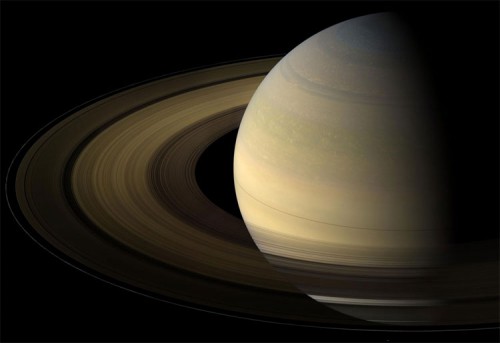
Photo Credit: NASA/JPL
Meteors flashing across the sky are a common sight here on Earth, but of course they are not limited to only our planet; these bits of rocky debris, smaller pieces of asteroids and comets known as meteoroids, can be found just about everywhere in the solar system (becoming meteors when entering and burning up in the atmosphere). Now, the Cassini spacecraft has observed similar impacts occurring in another very different and far-away place: the rings of Saturn!
Saturn’s rings are immense in scale—many times wider than Earth’s diameter—so it might be expected that meteoroids would collide with the ring material, too. It seems that they indeed do, and quite frequently.
The new observations make the rings another one of only a few places where such impacts have been directly observed by astronomers as they happen—the others being the Moon, Earth, and Jupiter. These impacts are also unique in that Saturn’s rings themselves are composed of countless bits of rock, ice, and dust. Other meteoroid collisions are with larger solid bodies like the Moon, or planetary atmospheres like on Earth and Jupiter.
As Linda Spilker, Cassini project scientist at NASA’s Jet Propulsion Laboratory, explains: “These new results imply the current-day impact rates for small particles at Saturn are about the same as those at Earth—two very different neighborhoods in our solar system—and this is exciting to see. It took Saturn’s rings acting like a giant meteoroid detector—100 times the surface area of the Earth—and Cassini’s long-term tour of the Saturn system to address this question.”

The meteoroids at Saturn have been estimated to range in size from about half an inch to several yards. Being able to find the tracks made by them in an area as big as Saturn’s rings took several years. In all, nine such tracks have been found so far, from 2005, 2009, and 2012. How do these tracks form? They resemble the meteor trails seen in the sky on Earth when a meteoroid burns up in the atmosphere, but here the process is a little different. It is thought that the meteoroids are broken apart as they first impact the ring material, creating even smaller pieces which then orbit Saturn. As these smaller bits hit the rings again, they form little clouds of dust that become extended by Saturn’s gravity, creating bright streaks that cut diagonally across the rings.
One of the best opportunities to observe the streaks was in summer 2009, during the Saturnian equinox. The streaks looked brighter against the darkened rings, due to the low Sun angle.
According to Matt Tiscareno, a participating Cassini scientist and lead author of the new paper: “We knew these little impacts were constantly occurring, but we didn’t know how big or how frequent they might be, and we didn’t necessarily expect them to take the form of spectacular shearing clouds. The sunlight shining edge-on to the rings at the Saturnian equinox acted like an anti-cloaking device, so these usually invisible features became plain to see.”
It would be an incredible sight to be able to watch these impacts from the vantage point of inside the rings themselves—a familiar kind of phenomenon but in a very alien environment.
The new results were just published in the April 25 edition of the journal Science. Larger versions of the impact images are available here.
Want to keep up-to-date with all things space? Be sure to “Like” AmericaSpace on Facebook and follow us on Twitter:@AmericaSpace




One Comment
One Ping
Pingback:Cassini sees meteor impacts in Saturn's rings - The Meridiani Journal